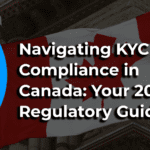
Navigating KYC Compliance in Canada: Your 2025 Regulatory Guide
January 24, 2025
The Top Compliance Mistakes Companies Make When Entering a New Market
January 31, 2025Financial crime compliance is an ever-evolving landscape requiring businesses to anticipate, mitigate, and monitor risks effectively. While organizations implement robust Anti-Money Laundering (AML) and Counter-Terrorist Financing (CTF) controls, one critical factor often overlooked is residual risk—the remaining risk after all mitigation measures have been applied.
Residual risk is unavoidable, but understanding and managing it effectively is crucial for regulatory compliance and financial security. This article explores its significance, real-world data, and strategies to keep it within acceptable limits.
What Is Residual Risk?
Residual risk is the level of risk that persists despite the application of preventive and detective controls. In financial crime compliance, residual risk arises due to several factors:
- Human Error: Employees may overlook red flags or make judgment errors in risk assessments.
- Emerging Threats: Criminal tactics evolve rapidly to bypass existing controls.
- Technology Gaps: No system is foolproof, and compliance technology may not detect every anomaly.
- Regulatory Ambiguities: Compliance frameworks vary across jurisdictions, leaving gaps in implementation.
Why Residual Risk Matters in Compliance
Ignoring residual risk can have severe consequences, including regulatory fines, reputational damage, and increased exposure to financial crime. Regulatory bodies like the Financial Action Task Force (FATF), FINTRAC (Canada), and the Financial Conduct Authority (FCA, UK) expect businesses to:
- Continuously assess and document residual risk levels.
- Demonstrate how controls mitigate inherent risks.
- Implement ongoing monitoring to detect risk fluctuations.
Data Insights: The Cost of Residual Risk Mismanagement
- In 2023, global AML non-compliance fines totaled $5 billion (Source: Reuters Financial Crime Report).
- A PwC compliance study found that 74% of financial institutions reported at least one major compliance breach linked to residual risk in the past five years.
- FINTRAC’s 2023 annual report highlighted that 60% of AML enforcement actions involved gaps in ongoing risk assessment frameworks.
How to Manage and Reduce Residual Risk
1. Implement a Risk-Based Approach
A dynamic, risk-based approach prioritizes high-risk areas and allocates resources accordingly. This ensures that the most critical threats receive immediate attention while minimizing exposure in low-risk areas.
2. Enhance Due Diligence (EDD)
For high-risk customers and transactions, businesses should conduct Enhanced Due Diligence (EDD) by:
- Performing deeper background checks.
- Verifying the source of funds.
- Conducting ongoing transaction monitoring.
3. Leverage Advanced Analytics & AI
AI-driven transaction monitoring systems can identify suspicious activities in real time. A Deloitte survey found that financial institutions using AI for AML compliance saw a 35% reduction in undetected risks.
4. Conduct Regular Risk Assessments
Frequent compliance audits and risk assessments help identify gaps in control effectiveness. Regulators expect businesses to update their Risk-Based Approach (RBA) annually to reflect emerging threats.
5. Strengthen Employee Training & Awareness
A well-trained workforce is the first line of defense against financial crime. Organizations should implement:
- Regular compliance training.
- Real-world AML simulation exercises.
- Updated policies reflecting the latest regulatory changes.
Regulatory Expectations & Best Practices
Governments and financial watchdogs worldwide are tightening compliance expectations. Here’s what businesses must do:
- FINTRAC & FCA Compliance: Canadian and UK regulators mandate that businesses document their risk assessments and update compliance frameworks regularly.
- FATF Recommendations: Global AML standards require that businesses measure residual risk and demonstrate proactive risk management strategies.
- Internal Controls & Governance: A robust compliance culture, led by a dedicated Chief Compliance Officer (CCO), ensures that financial institutions maintain transparency and accountability.
Conclusion & Next Steps
Residual risk is an inevitable aspect of financial crime compliance, but proactive management can keep it within acceptable thresholds. Businesses must integrate continuous monitoring, strong governance, and adaptive strategies to stay ahead of emerging threats.
At Paycompliance, we help organizations navigate the complexities of risk management, ensuring compliance frameworks are not just robust but also resilient in the face of evolving challenges. Contact us today to strengthen your risk mitigation strategy and safeguard your business against financial crime.
Sources:



